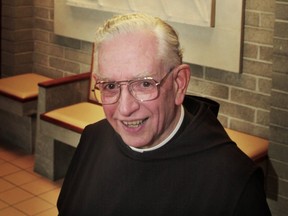Considered by many to be one of Canada’s most original artists, Father Dunstan Massey died on Boxing Day in the infirmary at Westminster Abbey in Mission, aged 98.
Art
Cloistered monk who spent his life adorning Mission’s Westminster Abbey dies at 98
Father Dunstan Massey, Order of St. Benedict, was considered one of Canada’s most original artists

“I had barely set foot in high school when I decided (amazingly with parental permission) that I would prefer to study art rather than algebra,” Massey once wrote.
So at 18 Massey turned his back on the secular world and began training for the priesthood at Christ the King Seminary, part of the abbey he would call home for his remaining 70 years, where his much-admired frescoes, paintings, bas-reliefs and sculptures abound and where he taught art, literature and philosophy.
The cloistered monk kept painting to the end, until he moved into the abbey’s infirmary a short time before his death, said Father Mark Dumont, Westminster’s guestmaster.
The other is called The Stone Ship: A Nocturne in Three Watches, and is also a poetic drama published in 2014, 12 years after Mystic.
As well, he had a book written about him, Artist in the Cloister, by historian Daphne Sleigh.
Born William Massey, he chose his priesthood name after Saint Dunstan of Canterbury, patron saint of artisans and goldsmiths.
The head of the Vancouver Art Gallery once told him he should get out more, become au courant, fully informed, up to date, he told The Vancouver Sun in 2002.
“It’s the last thing I want to do,” Massey said. “I don’t think I could have survived the rough-and-tumble of the modern art world.”
One big fresco of Massey’s is called The Vision of St. Benedict, depicting how his patron saint saw “the whole world in a ray of light,” a mystical moment of ecstasy. Another large fresco, The Celestial Banquet, was inspired by Leonardo da Vinci’s The Last Supper, only with Matthias the Apostle replacing Judas Iscariot.
It took Massey four years to complete Temptation, six years to finish Banquet, Westminster’s guestmaster Dumont said.
And it took seven years to craft the crucifix — cast in bronze and plated with silver — that has hung above the Westminster Abbey altar since 2014.
“An artist doesn’t very often get a chance to do the whole ornamentation of a church,” Massey told B.C. Catholic in 2017. “That’s a rare thing.
Massey’s life was a cycle of daily prayer, eating in silence, creating his art while listening to classical music and sleep, up again next morning for 5 a.m. breakfast to do it all over again.
His art, he once said, is meant to convey hope.
“I think our modern society needs hope more than anything, because there is so much alienation, which leads to despair.”
Art
40 Random Bits of Trivia About Artists and the Artsy Art That They Articulate – Cracked.com
[unable to retrieve full-text content]
40 Random Bits of Trivia About Artists and the Artsy Art That They Articulate Cracked.com
Source link
Art
John Little, whose paintings showed the raw side of Montreal, dies at 96 – CBC.ca
[unable to retrieve full-text content]
John Little, whose paintings showed the raw side of Montreal, dies at 96 CBC.ca
Source link
Art
A misspelled memorial to the Brontë sisters gets its dots back at last
LONDON (AP) — With a few daubs of a paintbrush, the Brontë sisters have got their dots back.
More than eight decades after it was installed, a memorial to the three 19th-century sibling novelists in London’s Westminster Abbey was amended Thursday to restore the diaereses – the two dots over the e in their surname.
The dots — which indicate that the name is pronounced “brontay” rather than “bront” — were omitted when the stone tablet commemorating Charlotte, Emily and Anne was erected in the abbey’s Poets’ Corner in October 1939, just after the outbreak of World War II.
They were restored after Brontë historian Sharon Wright, editor of the Brontë Society Gazette, raised the issue with Dean of Westminster David Hoyle. The abbey asked its stonemason to tap in the dots and its conservator to paint them.
“There’s no paper record for anyone complaining about this or mentioning this, so I just wanted to put it right, really,” Wright said. “These three Yorkshire women deserve their place here, but they also deserve to have their name spelled correctly.”
It’s believed the writers’ Irish father Patrick changed the spelling of his surname from Brunty or Prunty when he went to university in England.
Raised on the wild Yorkshire moors, all three sisters died before they were 40, leaving enduring novels including Charlotte’s “Jane Eyre,” Emily’s “Wuthering Heights” and Anne’s “The Tenant of Wildfell Hall.”
Rebecca Yorke, director of the Brontë Society, welcomed the restoration.
“As the Brontës and their work are loved and respected all over the world, it’s entirely appropriate that their name is spelled correctly on their memorial,” she said.
The Canadian Press. All rights reserved.
-
News22 hours ago
Freeland says she’s ready to deal with Trump |
-
News22 hours ago
NASA astronauts won’t say which one of them got sick after almost eight months in space
-
News22 hours ago
43 monkeys remain on the run from South Carolina lab. CEO thinks they’re having an adventure
-
News23 hours ago
Freeland rallies a united front ahead of Trump’s return to White House
-
News23 hours ago
Deputy minister appointed interim CEO of AIMCo after Alberta government fires board
-
News23 hours ago
Montreal says Quebec-Canada dispute stalling much-needed funding to help homeless
-
News23 hours ago
S&P/TSX composite index down Friday, Wall St. extends post-election gains
-
News22 hours ago
Mitch Marner powers Matthews-less Maple Leafs over Red Wings